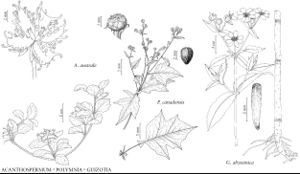Guizotia
in F. Cuvier, Dict. Sci. Nat. ed. 2, 59: 237, 247, 248. 1829.
| Taxon | Illustrator ⠉ | |
|---|---|---|
 | Acanthospermum australe Polymnia canadensis Guizotia abyssinica | Barbara Alongi Linda Ann Vorobik Yevonn Wilson-Ramsey |
Annuals [perennials, subshrubs, or shrubs], [3–] 20–200 cm. Stems erect [creeping], branched. Leaves mostly cauline; opposite (distal sometimes alternate); sessile; blades rhombic to lanceolate or oblanceolate [spatulate], margins entire or serrate, faces glabrous or puberulent to pilose, glanddotted (at least abaxial). Heads radiate, in corymbiform arrays [borne singly]. Involucres campanulate [hemispheric], [8–] 10–15 [–20] mm diam. Phyllaries persistent, 10–13 in 2 series (distinct, outer 5–6+ oblong, herbaceous, inner narrower, more scarious). Receptacles conic to hemispheric, paleate (paleae oblong to lanceolate, plane [cucullate], membranous to scarious). Ray-florets 6–18, pistillate, fertile; corollas yellow (hairy at bases of tubes). Disc-florets 100+, bisexual, fertile; corollas yellow, tubes cylindric (hairy), shorter than campanulate throats, lobes 5, deltate. Cypselae weakly compressed, 3–4-angled, glabrous (shining); pappi 0. x = 15.
Distribution
Introduced; Africa
Discussion
Species 6 (1 in the flora).
Taxonomic affinities of Guizotia generally have been acknowledged as obscure; the genus has been placed in Coreopsidinae, Melampodiinae, Milleriinae, and Verbesininae.